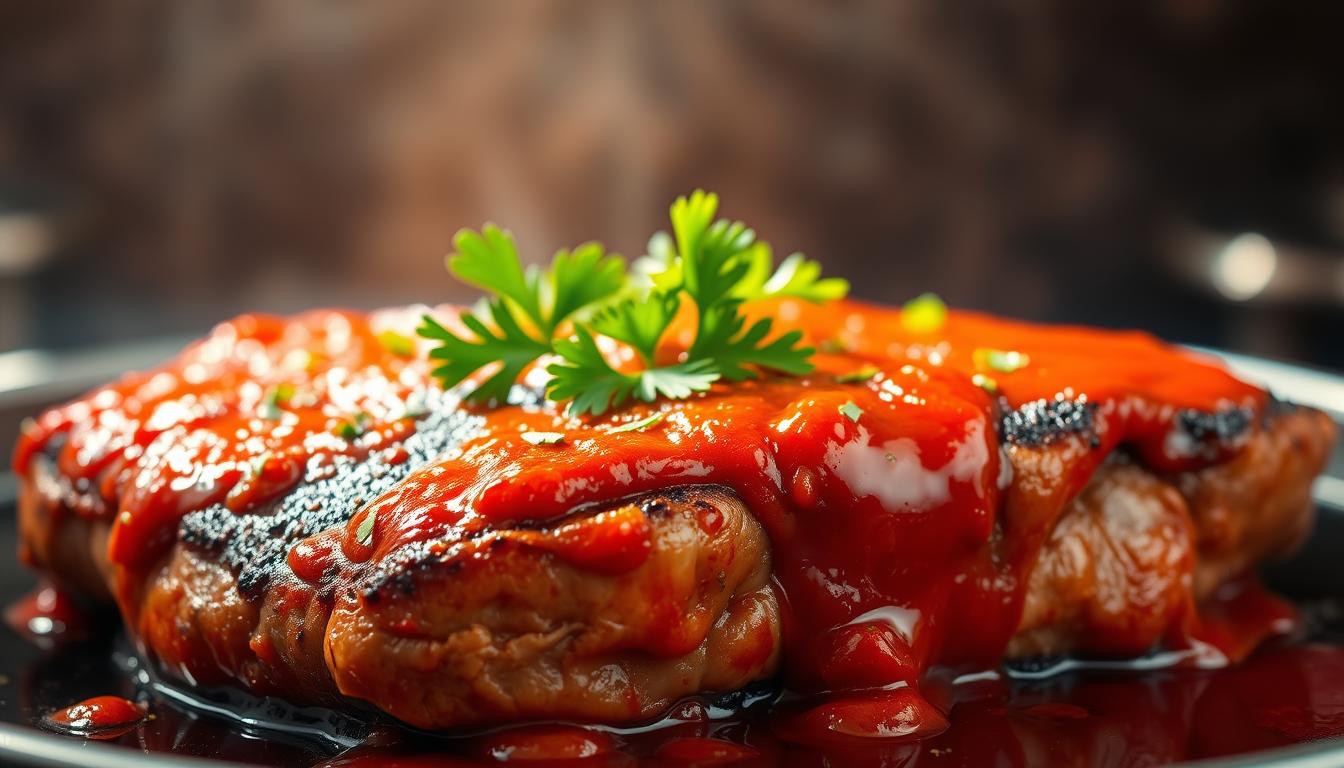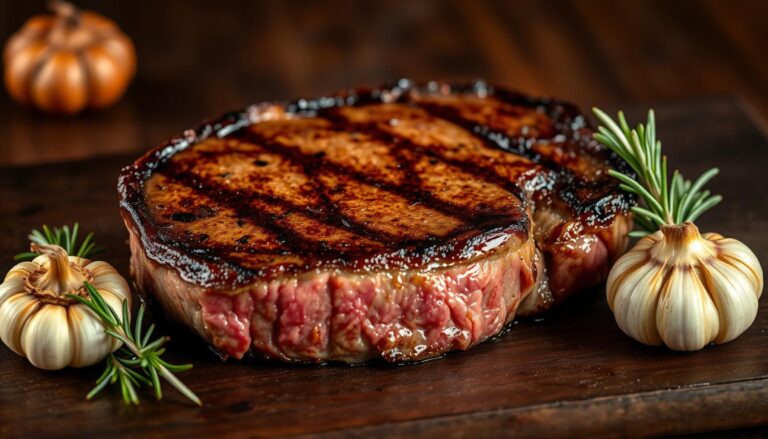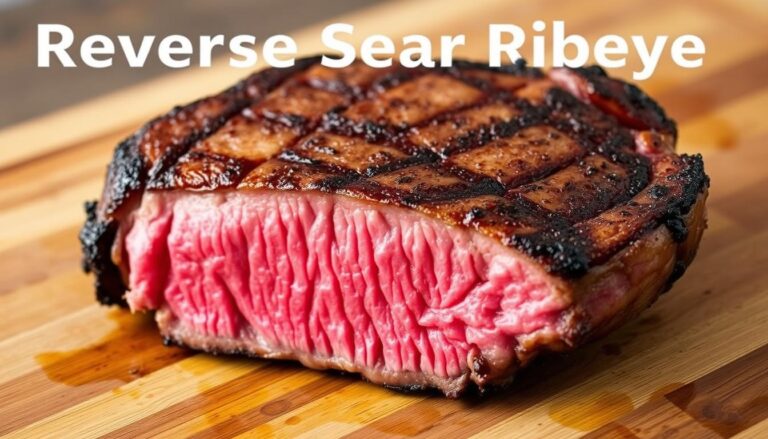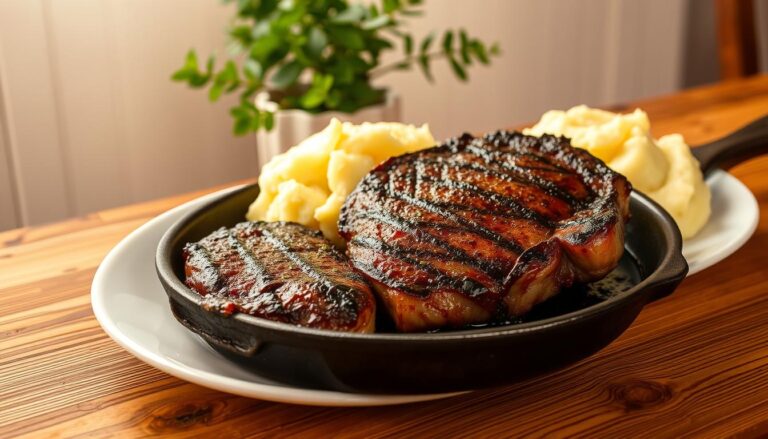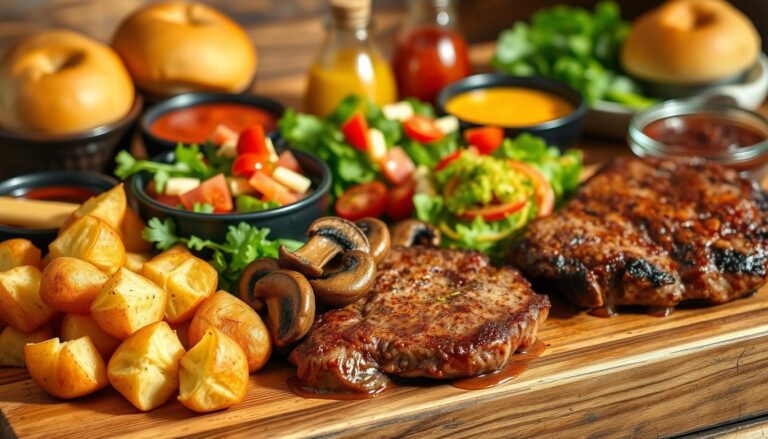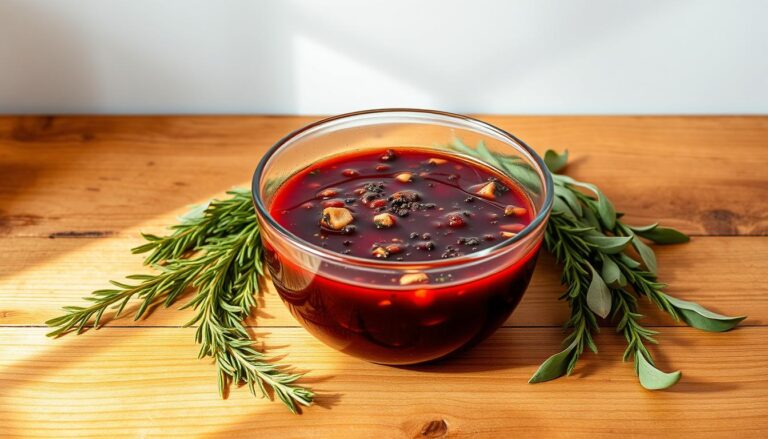Savory Red Sauce Steak: A Mouthwatering Dish
You know that urge to recreate a restaurant night at home? Tonight, you can. This recipe gives you a clear plan to pan-sear a thick ribeye and finish it with a glossy pan sauce that tastes like effort, not fuss.
You get step-by-step guidance on preheating a 12-inch cast iron skillet, reverse-searing for perfect doneness, and using drippings with garlic, shallots, wine, and beef stock to make a rich sauce in minutes.
Along the way, you learn when to choose a quick stovetop method for thinner cuts and when to braise tougher pieces in a tomato-forward sauce. The timing notes help you pull the meat at target temps and rest it for that ideal carryover rise.
By the end, you’ll know how to balance crust and jus so your weeknight meal looks and tastes like a celebration.
Table of Contents
Why You’ll Love This Red Sauce Steak Recipe
Choose the approach that fits your night: you can make a quick pan reduction using drippings or simmer the cut in a Neapolitan-style pizzaiola. Both give your meat a savory finish that clings to each slice.
What this term means: one path is a pan-sear finished with a wine reduction made from fond. The other is a steak pizzaiola simmered in tomato sauce with olive oil, garlic, oregano, and a splash of white wine.
Pick a method based on your available time and the cuts you have. Reverse-sear thicker ribeye for a precise interior and crust. Thin cuts get a quick sear and a brief sauce finish. Tougher pieces braise longer until tender.
- You build flavor in the pan so the final dish feels restaurant-level with simple steps.
- Wine adds depth; tomato brings brightness and umami for family-friendly meals.
- Follow visual cues for sauce consistency and doneness to avoid guesswork.
| Method | Best For | Typical Time |
|---|---|---|
| Wine reduction | Thick, marbled cuts | 10–15 minutes |
| Pizzaiola (tomato) | Thin or tougher cuts | 20–40 minutes |
| Braise in sauce | Lean, tough meat | 45–90 minutes |
Ingredients You’ll Need and Smart Substitutions
Start by matching the meat and tomatoes to the technique you’ll use so each element cooks in sync.
Cuts and thickness
Ribeye shines with a reverse sear; pick a ribeye at least 1½–2 inches thick for the best crust and even interior. USDA Prime offers more marbling, while Choice gives good value.
If you prefer quicker cooks, go ½–¾ inch for thin cuts like flank or sirloin when you plan a fast pan finish.
Tomato choices
For a tomato-driven base, use certified San Marzano tomatoes or a quality tomato sauce and cook tomato paste briefly to deepen flavor. Simmer tomato sauce 40–45 minutes to meld flavors.
Fresh tomatoes — heirloom or cherry — work in season for brightness or as a partial swap for canned tomatoes.
Wine, aromatics, and pantry staples
Pick Zinfandel for a bold reduction or Pinot Noir for a smoother wine finish. Use a splash of white wine to deglaze before adding tomato sauce.
Build the base with olive oil, garlic, and shallots, then layer oregano, basil, rosemary, and thyme. Finish with butter for gloss and extra depth.
Seasoning strategy
“Season steaks generously with salt and black pepper early to draw moisture and build a better crust.”
Season early, then adjust salt at the end of sauce cooking since reductions concentrate flavor.
- Choose cuts to match cooking time: ribeye for quick reverse-sear, sirloin/flank for sauce braises.
- Measure liquids smartly — think 1 cup wine to 1 cup beef stock for a balanced pan reduction.
- Swap dried herbs if fresh basil or oregano aren’t available; canned tomatoes are a reliable backup.
| Ingredient | Use | Tip |
|---|---|---|
| Ribeye | Reverse-sear, 1½–2 inch thick | Prime for more marbling, Choice for value |
| San Marzano tomatoes | Tomato-forward sauce | Simmer 40–45 minutes for depth |
| Zinfandel / Pinot Noir | Wine reduction or enrichment | Zinfandel = bold; Pinot Noir = smooth |
| Olive oil, garlic, shallots | Flavor base | Sear gently, then deglaze with wine |
Tools, Pan, and Heat: Set Yourself Up for Success
A simple prep of pan, rack, and thermometer sets you up to hit perfect doneness every time.
Why a 12-inch cast iron skillet works best
Preheat a heavy 12-inch cast iron skillet in a 275ºF oven so it warms evenly. That steady warmth helps the skillet hold heat at the stovetop and build deep browning.
The hot iron preserves fond and gives you a better base for a glossy pan sauce.
Prep for even cooking and precise temps
Set steaks on a wire rack over a foil-lined sheet pan to dry the surface. Dry meat browns faster and avoids steaming when it hits the pan.
Use a reliable digital thermometer to monitor internal temp during the oven and searing stages. Move from oven to sear when the thermometer hits your target.
- Heat the pan until the oil shimmers and just begins to smoke — that signals it’s ready to sear.
- Keep the pan roomy so pieces don’t crowd; crowding cools the surface and ruins a crust.
- Have tongs, a spoon for basting, and a heat-safe spatula nearby for smooth transitions.
- Use a bit of neutral oil for the initial sear, then finish with butter for flavor and browning.
| Tool | Purpose | Key Tip |
|---|---|---|
| 12-inch cast iron skillet | Even heat, deep browning | Preheat in 275ºF oven |
| Wire rack & sheet pan | Surface drying, airflow | Line pan with foil for easy cleanup |
| Digital instant-read thermometer | Precise doneness control | Check during oven and after sear |
Step-by-Step: Sear, Sauce, and Serve
Start by prepping your meat and pan so every sear and sauce step runs smoothly.
Dry, season, and preheat
Pat the cuts very dry and season generously with salt and black pepper. Preheat a 12-inch cast iron skillet in a 275ºF oven, then move it to high heat on the stovetop.
Reverse-sear for thicker cuts
For a 1½–2 inch thick ribeye, bake on a wire rack to 90–95ºF for medium-rare or 100–105ºF for medium. Check at 15 minutes, then every 5 minutes.
Increase heat, add a thin film of oil, and sear 2 minutes on the first side, 1½–2 minutes on the second. Render edges about 2 minutes.
Quick sear for thinner cuts
For a ½–¾ inch ribeye, sear 2–3 minutes per side. Flip once you see deep browning to avoid overcooking.
Basting and resting
Add butter with garlic and shallots in the final moments and baste by tilting the pan. Deglaze with a splash of wine if desired, then rest meat 10 minutes before slicing against the grain.
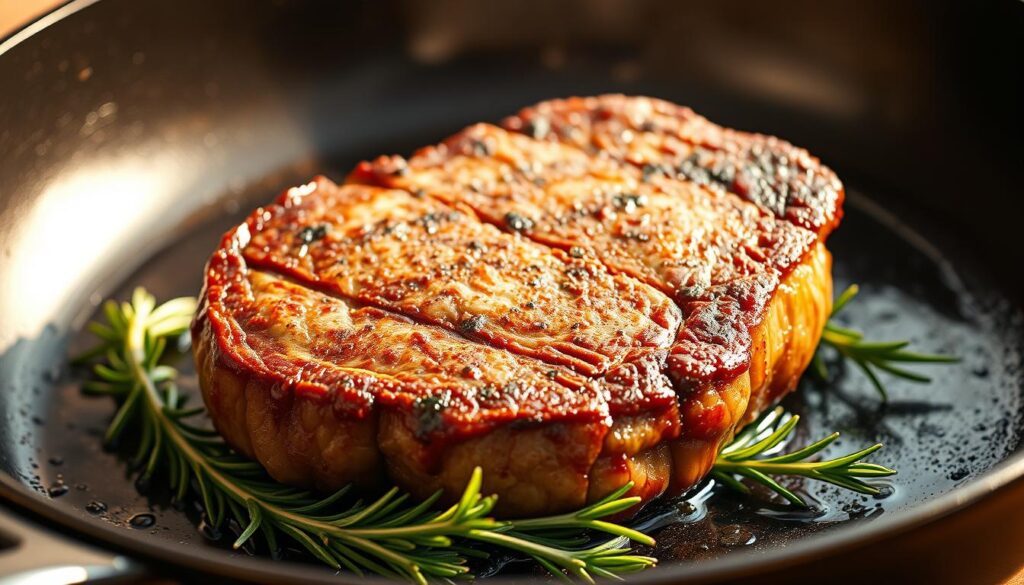
| Cut | Oven Temp/Check | Sear Time |
|---|---|---|
| 1½–2 inch ribeye | 275ºF to 90–95ºF (MR) | 2 min / 1½–2 min + 2 min edges |
| ½–¾ inch ribeye | Pan only, target 120ºF MR | 2–3 min per side |
| Tougher cuts (braise) | Low oven or simmer | 45–90 minutes |
Mastering Sauces for Red Sauce Steak
Let the cut and your available time decide whether you make a concentrated pan glaze or a simmered Italian-style tomato blend.
Red wine reduction in the same skillet: Sauté minced shallots and garlic in the pan drippings. Add 1 cup dry wine (Zinfandel or Pinot Noir) and reduce by half, about 3–4 minutes.
Stir in beef stock, a splash of balsamic, rosemary, and thyme. Reduce to roughly ½ cup, then whisk in cold butter for shine. Season to taste and spoon over the resting ribeye.
Steak pizzaiola tomato approach: Warm olive oil with garlic and a pinch of chili flakes. Cook tomato paste 4–5 minutes, add San Marzano tomato sauce with basil and oregano, then simmer 40–45 minutes.
Deglaze the skillet with white wine for 3–4 minutes, return the pan juices, nestle the meat in, and finish to desired doneness. Tougher cuts can braise 20–60 minutes.
“A quick reduction suits thicker, seared cuts; a long tomato simmer makes tougher pieces tender and saucy.”
| Method | Best For | Key Steps |
|---|---|---|
| Wine reduction | Thick seared cuts | Sauté shallots, add 1 cup wine, reduce, add beef stock, finish with butter |
| Steak pizzaiola | Tough or saucy plates | Bloom garlic, cook tomato paste, simmer tomato sauce, deglaze with white wine |
| Quick pan glaze | Weeknight ribeye | Deglaze, reduce briskly, glaze steaks in final minutes |
Doneness, Timing, and Troubleshooting
Nailing doneness is about temperature, timing, and reading the pan as much as following a clock.
Target temperatures
You aim for 120–125°F for medium-rare and about 130–140°F for medium. Remember carryover will raise the internal temp a few degrees while the meat rests.
Oven checkpoints and pan cues
For reverse sear, check internal temp at 15 minutes in the oven, then every 5 minutes. Pull at 90–95°F for medium-rare or 100–105°F for medium before searing.
Sear roughly 2 minutes on the first side, 1½–2 minutes on the second, and render edges about 2 minutes total. Watch color and a vigorous sizzle in the pan to know when to flip.
Troubleshooting sauce and seasoning
If the sauce is thin, increase heat and continue to reduce until it coats the back of a spoon. If the sauce tastes sharp, finish with a cold pat of butter or a splash of beef stock to balance acidity.
Season with a final pinch of salt and a touch of pepper after reduction so you don’t overshoot salinity. For thinner pizzaiola-style cooks, plan about 6 minutes, flip, then 3–4 more minutes for medium-rare; tougher cuts may need 20–60 minutes in tomato-based braises.
“Check temps early and often; the combination of your thermometer and pan cues will guide better results.”
| Check | When | Action |
|---|---|---|
| Internal temp (reverse sear) | 15 min, then every 5 min | Pull at 90–95°F (MR) or 100–105°F (M) |
| Sear timing | After oven or direct pan | 2 min first side; 1½–2 min second; 2 min edges |
| Sauce fix | Too thin or sharp | Reduce on high heat or finish with butter/stock |
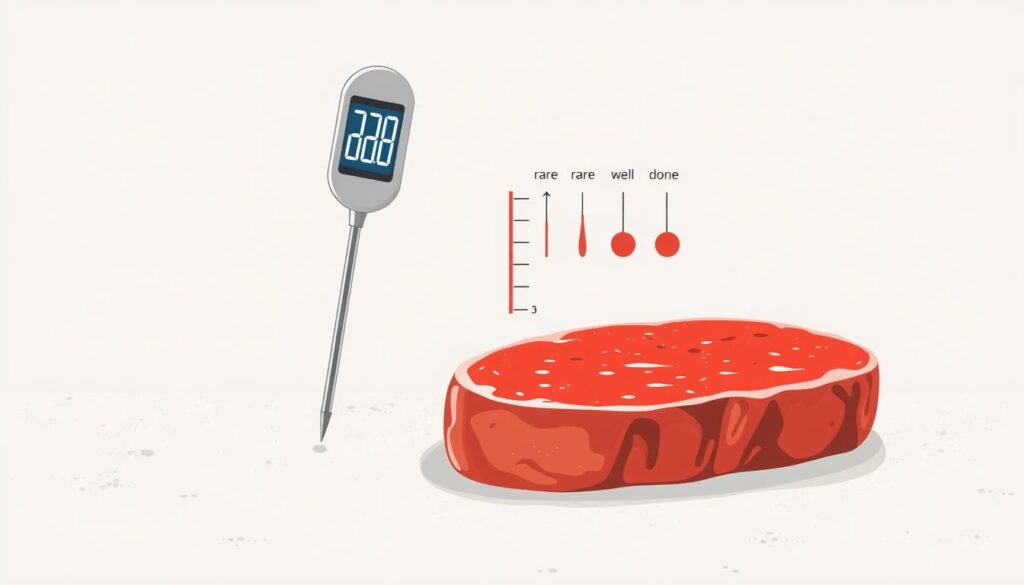
Serving Ideas, Sides, Storage, and Make-Ahead Notes
A well-chosen side can turn the plate from simple to memorable. Serve this dish with items that love a rich pan jus so every bite stays juicy and bright.
Pairings that work
Choose crusty bread to soak up sauce, or set the meat over al dente pasta or creamy polenta. Finish with a scatter of fresh basil and a light drizzle of olive oil for aroma and shine.
Make-ahead sauce
You can cook the tomato sauce 1–2 days ahead to speed weeknight dinners. Reheat gently, then deglaze the pan with a splash of white wine before nesting the steaks back in to finish.
Leftovers and freezing
Refrigerate leftovers for 3–4 days. For longer storage, freeze up to 3 months; keep the meat submerged in sauce to protect texture.
Reheating tips
Warm covered in a pan over low heat so the sauce brings the interior up without overcooking. If the sauce thickens, stir in a small cup of reserved pasta water and re-season to taste.
- Plate each serving with plenty of sauce so every slice stays moist.
- Slice the steak just before serving and fan pieces over the sauce for a neat presentation on the plate.
- Add chopped olive or an extra drizzle of olive oil for a briny, rich finish.
“Ladle extra sauce onto the plate so every bite stays juicy and flavorful.”
Conclusion
With a preheated cast iron skillet and a good thermometer, you can move from oven to sear and finish your ribeye with confidence. Pick a quick wine reduction for a glossy pan glaze or a longer tomato simmer for braised depth. Both approaches yield a juicy, well-seasoned result when you control heat and rest the meat.
Use simple pantry staples — tomatoes, garlic, oregano, basil, olive oil, salt, and pepper — plus a cup of wine when you want a silky finish. Match the method to the cut: reverse-sear thick pieces, quick-sear thinner ones, or braise tougher steaks in tomato and herbs for tenderness.
You now have clear notes on temps, timing, and seasoning to make this dish reliably. Try variations like olives or extra herbs to put your own spin on the recipe and serve it any night with confidence.

